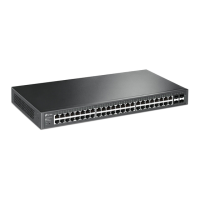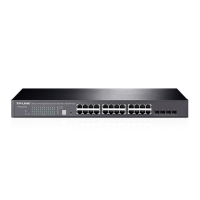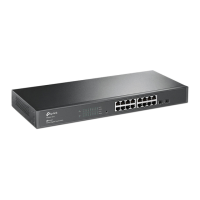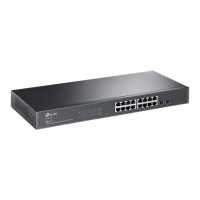Configuration Guide 458
Configuring QoS Auto VoIP Configuration
Step 3 interface {fastEthernet
port
| range fastEthernet
port-list
| gigabitEthernet
port
| range
gigabitEthernet
port-list
| ten-gigabitEthernet
port
| range ten-gigabitEthernet
port-list
| port-
channel
port-channel-id
| range port-channel
port-channel-list
}
Enter interface configuration mode.
Step 4 Select the interface mode for the port.
no auto-voip
Specify the interface mode as disabled, which means the Auto VoIP function is disabled on the
corresponding port.
auto-voip none
Specify the interface mode as none. In this mode, the switch allows the voice devices to use its
own configuration to send voice traffic.
auto-voip
vlan-id
Specify the interface mode as VLAN ID. In this mode, the voice devices will send voice packets
with desired VLAN tag. If this mode is selected, it is necessary to specify the 802.1Q VLAN ID.
The valid values are from 1 to 4093.
In addition, you need to configure the 802.1Q VLAN to ensure the corresponding ports can
forward the packets normally.
auto-voip dot1p
dot1p
Specify the interface mode as dot1p. In this mode, the voice devices will send voice packets
with desired 802.1p priority. If this mode is selected, it is necessary to specify 802.1p priority.
The valid values are from 0 to 7.
In addition, you can configure the Class of Service to make the switch process the packets
according to the 802.1p priority.
auto-voip untagged
Specify the interface mode as untagged. In this mode, the voice devices will send untagged
voice packets.
Step 5 auto-voip data priority {trust
| untrust}
Enable or disable the Class of Service override mode. By default, it is trust, which means the
Class of Service override mode is disabled.
trust: In this mode, the switch will then put the voice packets in the corresponding TC queue
according to the 802.1p priority of the packets.
untrust: In this mode, the switch will ignore the 802.1p priority in the voice packets and put the
packets in TC-5 directly.
Step 6 auto-voip dscp
value
Specify the value of DSCP priority. The voice device will send the packets with the
corresponding DSCP value.
In addition, you can configure the Class of Service to make the switch process the packets
according to the DSCP priority.
value:
Enter the value of DSCP priority. The valid values are from 0 to 63 and the default value
is 0.

